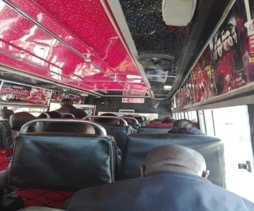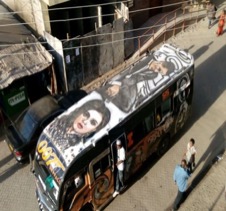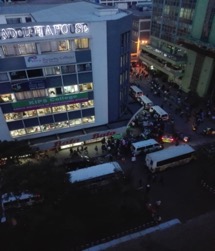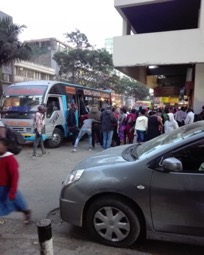Exploring Public Road Passenger Transport in Kenya
By Gladys Moraa Marie Nyachieo, Kenyatta University, Kenya
This work is based on a conference paper presented during the 15th Annual T2M Conference (Mobile Utopia Conference). The original paper was entitled “Exploring ‘Public’ Road Passenger Transport In Kenya: A Futuristic Utopia Or Dystopia?”Presented at Lancaster University, November 2-5, 2017. United Kingdom. The author focuses on the dynamics and challenges of public road passenger transport in Kenya while looking at it short history.
Public road passenger transport in Kenya dates back to the 1930s, but a lot has changed due to increase in population and urbanization. Road transport accounts for over 80 percent of the total internal freight and passenger traffic in Kenya with the remainder of about 7 percent being mainly carried by rail and air. Kenya’s road network serves both domestic and regional passenger and freight transport demand. In Kenya, there is currently no state-operated road passenger public transport service.
Instead, public transport is mainly dominated by the informal sector commonly referred to as Paratransit. This is composed of privately-owned and operated transport options that include matatus (buses, mini buses, vans), motorcycles (boda boda), bicycles and tricycles (tuk tuk). Due to the lack of organized public passenger transport, alternatives have led to rapid growth in these non-conventional means of public transport.
Paratransit has the advantage of responding to the demand for motorized mobility from a large percentage of urban residents to satisfy a need for travel that cannot be met by walking. With thousands of vehicles in a city and minimal regulation of routes, paratransit responds quickly to changes in demand. This demand could be as a result of ordinary daily and seasonal changes, or longer-term changes brought about by competing forms of transport, and/or changes in mobility patterns.
Although paratransit often appears to be disorderly, it is actually an intricate system that involves quite a large number of different players. Paratransit in Kenya is characterized by flexibility and demand responsiveness, lack of schedules, fluctuating fares, poor working conditions, competition, formation of cartels and unpredictable stops and routes.
After the inception of the first buses to offer organized mass transport for passengers especially in Nairobi, there were many challenges that led to its collapse. Kenya Bus Services (KBS) which was owned by the Overseas Transport Company of London was the first form of Private Public Partnership (PPP) in Public Road Passenger Transport (PRPT). KBS remained the sole operator of bus transit till the 1970’s when matatus (Para-transit) came into the picture. The state then introduced Nyayo Bus Service in 1986 which was subsidized but inefficient after operating for seven years, Stagecoach closed shop therefore ending public sector participation in PRPT.
Matatus started operating before independence in the mid-1950s. They came into operation due to a lack of public transport in areas around Eastlands, a result of colonial restrictions. After independence in 1963, there was significant growth especially in Nairobi. This growth lead to rural-urban migration and therefore increased demand.
With the increase in population and urbanization, passenger journeys per day have also increased. Currently, the population of Nairobi is about 3 million residents, and a daytime population of 4.5 million people who need to commute through the city. Therefore, there is need for elaborate urban transport services to serve mobility needs of this big and increasing population.
The name Matatu originated from a Kikuyu word (mang’otore matatu) meaning, “three cents.” That was the standard fare for most trips. After independence, the local informal sector lobbied to have matatus operate as public transport. This was effected through a presidential decree in 1973. Allowing free operation without regulation was the beginning of the chaotic transport system that has characterized the Kenyan road transport sector for a long time now.
The demand that could not be met by the Kenya Bus Service under The Overseas Transport Company (OTC) was filled by matatus, operating informally and illegally. Since their inception, matatus have increased in number because they were primarily not regulated and therefore, not taxed. The illegal matatu sector has created many jobs and contributed to the economy.
Currently, about 80 per cent of those using urban public transport are served by matatus. It was not until 1984 that matatus were required to have PSV license due to a new policy. By 2000, there were about 40,000 matatus in operation in Kenya. But as much as the matatu sector is important in the Kenyan economy, the workers in this sector often complain of poor labor conditions characterised by long hours, harassment from the police and county council askaris, fear of job loss, lack of proper payment structures in terms of salary, among other issues.
In an attempt to streamline the matatu sector, several policy interventions have been put in place. Among the latest directives aimed at streamlining the matatu industry was cashless transactions to enable taxation and regulate fares that keep fluctuating. Ultimately, this initiative failed due to complicated power structures that exist around the public transport system in Kenya.
Commuters in Nairobi are now able to get around easily, because matatu routes have now been mapped and made available on Google maps. This has transformed the travel experience of the passengers. Aesthetic elementss are also used to compete for passengers. Matatus have resorted to elaborate interior design and furnishings on the outside with flashy lights and big screen televisions. In addition, WI-FI and music is now a common feature for passenger road transport in Kenya. The matatus are also used as a means of advertising through digital media signage among others. This has transformed the mobility space for most passengers.
Images: examples of “pimped” Matatus in Nairobi, Route 111


The entry of boda boda motorcycles as a mode of transport (commercial motorcycles as taxis) in the already chaotic public passenger transport sector brought even more chaos. The zero rating of motorcycles below 250cc in Kenya in 2008 by the government meant that more people could afford them. Just like matatus, the boda boda started off without any form of regulation. Boda boda motorcycles became popular because they could use all possible routes to get their pillion passengers to their destination even during heavy traffic congestion.
Therefore, the current public passenger transport services have the following common features:
- a blend of all forms of travel modes (paratransit)
- over-crowding/overloading
- long queues of commuters at “termini”
- vehicular congestion arising from poor road space usage and planning by private vehicles, non-motorized transport, roadside vendors, among others
- low occupancy (e.g. 10-14 seaters) vehicles used by public service vehicle operators
- insufficient supply and use of non motorized and intermediate means of transport
- lack of standards in the design and manufacture of vehicles
- poor road design, e.g. inadequate drop-off and pick-up points
Challenges facing road passenger transport in Kenya are chaos and disorder. After the implementation of the famous Michuki laws (via legal notice No. 161 of 2003) there was a form of normalcy and orderliness for a time. But the situation has gone back to chaos since the actors do not adhere to traffic rules and there is poor enforcement of the rules.
Another challenge in the sector is cartels. Cartels in the matatu sector are said to work with the matatu crew and stage managers to harass and steal from commuters. Matatu cartels in Kenya operate like gangs. First, they do not allow new entrants into the matatu business unless one pays a huge amount of money to them. Secondly, they manage transport routes and matatu terminals and shield them from “outsiders”. It is also rumored that cartels work in cahoots with the police to commit crimes.
Alongside matatu sector cartels/gangs, there are other major challenges: rude, abusive crews; no stopping at zebra crossings; overcharging passengers; reckless driving; overloading; picking passengers at any place including the middle of the road; high incidences of unsafe vehicles; blocking the roads; nonstop hooting and whistle-blowing by touts banging on the sides of vehicles.
Images: Passengers queuing for matutus in Nairobi.


Moreover, in Kenya an estimated 3,000 deaths occur from road crashes annually. Many public transport service vehicles are involved in traffic accidents, and many lives are lost due to a lack of safety regulations on these vehicles.
These issues have inevitably led to some policy and practical changes in public road transport. Reforms in the transport sector can be seen through the creation of the National Transport Safety Authority (2012). The adoption of the IntegratedNational Transport Policy (INTP) attempted to give directions to deal with challenges in public transport. In the same year, Traffic Amendment Act (2012) introduced a number of regulations and severe penalties for traffic offences. It also highlighted the regulations targeting boda boda transport. The requirement for that paratranist groups join savings and credit cooperatives (SACCOs) was another new development to ensure smooth running of the transport affairs through self-regulation. All matatus or public transport vehicles must belong to a SACCO. Finally, one of the most recent drivers for reform was the creation of the Nairobi Metropolitan Area Authority (NAMATA) to be responsible for transport policy to help develop the city’s metropolitan area and oversee the implementation of the integrated transport master plan.
Works Cited
- Aduwo, I.G. (1990). The role, efficiency and quality of services of the matatu mode of public transport in Nairobi: A geographical analysis (Unpublished MA thesis). University of Nairobi.
- Asingo, P. (2004). The institutional and organizational structure of public road transport in Kenya. Institute of Policy Analysis and Research, Nairobi Kenya.
- Behrens, R., McCormick, D., & Mfinanga, D. (2015) “Introduction to paratransit in sub-saharan Africa.” In Behrens et al (Ed), Parantransit in African Cities: Operations, regulations and reforms. New York. Routeledge.
- Chitere, P.O. (2004). “Matatu industry in Kenya: A study of the performance of owners, workers and their associations and potential for improvement.” IPAR Discussion Paper No.055 Nairobi. Institute of Policy Analysis and Research.
- Chitere, P.O. (2006). “Public service vehicle drivers in Kenya; Their characteristics and
compliance with traffic regulations and prospects for the future.” IPAR
Discussion paper no-081/2006. Nairobi: Institute of Policy Analysis and
Research. - Government of Kenya (2004). Economic survey 2017. Nairobi Central Bureau of Statistics.
- Howe, J. (2003). “Filling the middle: Uganda’s appropriate transport services.” Transport Reviews, 2003, 23(2), 161-176. Oxford, UK.
- Integrated Urban Development Masterplan For The City Of Nairobi (Niuplan), 2014-2030. Stakeholder Meetings Nairobi City County, January – February 2014.
- International Association of Public Transport (2010). Public transport in Sub-Saharan Africa. Trans-African consortium, Brussels. Retrieved from link.
- Khayesi, M. (1999). An analysis of the pattern of road traffic accidents in relation to selected socio economic dynamics and intervention measures in Kenya (Unpublished PhD Thesis). Kenyatta University, Nairobi.
- Kumar, A. (2011). Understanding the emerging role of motorcycles in African cities: A
political economy perspective. Sub-Saharan Africa Transport Policy Program
(SSATP) discussion paper; no. 13. Retrieved from link. - Ministry of Transport, (2009). Integrated National Transport Policy. Nairobi: Government Printer.
- Moraa, G. (2010). Road safety in Kenya: Knowledge attitudes and practices of passenger service vehicles. LAP LAMBERT Academic Publishing GmbH& Co; Mauritius.
- National Transport Safety Authority,( 2015). Road safety status report. Retrieved from link.
- Nyachieo, G. M. M. (2015). Socio-cultural and economic determinants of boda boda
motorcycle transport safety in Kisumu County, Kenya. (Unpublished PhD thesis).
Kenyatta University Repository. - WHO (n.d) Motorcycle-related road traffic crashes in Kenya facts & figures. Retrieved from link.
